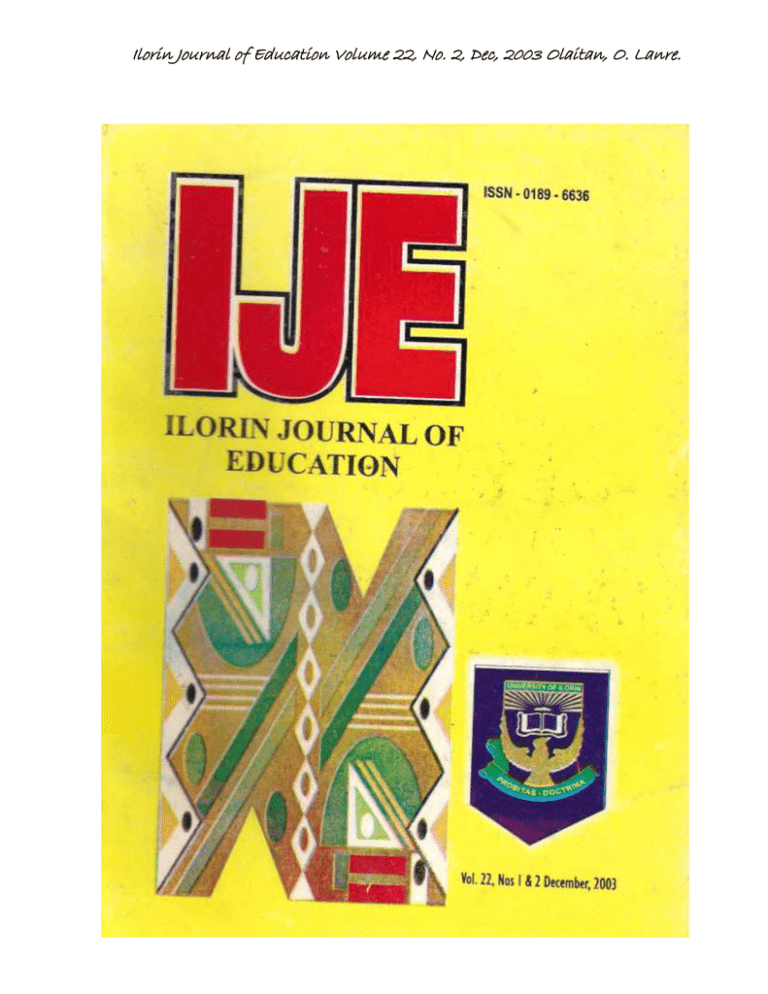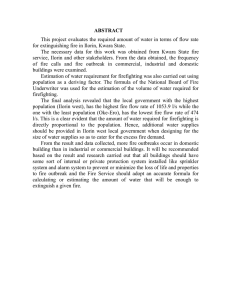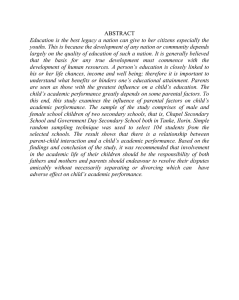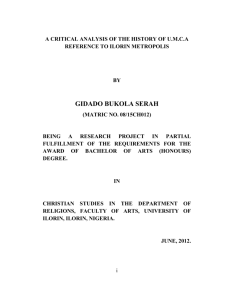
Ilorin Journal of Education Volume 22, No. 2, Dec, 2003 Olaitan, O. Lanre.
Ilorin Journal of Education Volume 22, No. 2, Dec, 2003 Olaitan, O. Lanre.
Ilorin Journal of Education, Volume 22, No. 1 June, 2003
ILORIN JOURNAL OF EDUCATION
All rights reserved. No part of this publication may be reproduced,
stored in a retrieval system or transi1fted in’ any form or by any
means, electronic, mechanical, photocopying, recording or
otherwise, without the permission of the copyright owners.
FACULTY OF EDUCATION,
UNIVERSITY OF ILORIN, ILORIN, NIGERIA.
© IJE 2003
ISSN 0189-6636
1-laytee Press and Publishing Co. Nig. Ltd.
154, Ibrahim Taiwo Road, P.O. Box 6697, Ilorin
031-221801, 08033604983
Ilorin Journal of Education Volume 22, No. 2, Dec, 2003 Olaitan, O. Lanre.
Ilorin Journal of Education, Volume 22, No. 1 June, 2003
NOTES TO CONTRIBUTORS
1.
Manuscript should be submitted in triplicate copies to the Managing
Editor.
2.
Manuscript must be typewritten, double spaced on A-4 sheets, and typed
on one side only. It should be accompanied by an abstract of not more
200 words in length.
3.
Manuscript type(written as indicated above, should be between 10 and 15
pages in length, including the abstract.
4.
Corrected version of article accepted for publication in the Journal, should
be submitted in a diskette (using Microsoft word 7)along with the
corrected/assessed copy.
5.
Details of reference to each work cited {including sources of tables and
diagrams) must be given.
6.
The Journal adopts the APA writing style and referencing pattern.
7.
All correspondences should be addressed to
The Managing Editor,
Ilorin Journal of Education,
Faculty of Education,
University of Ilorin.
liorin. Nigeria.
Ilorin Journal of Education Volume 22, No. 2, Dec, 2003 Olaitan, O. Lanre.
EDITORIAL BOARD
Editor-in-Chief
Professor E.A. Ogunsakin
Managing Editor
Dr. A,Y. AbduiKêreem
Associate Editors
Dr. M. O. Yusuf
Dr. E.A. Adeoye
Member.
Dr. A,A. Adeeoye
Dr. M,A. omogo
Dr. H. Owolabi
Dr. L.A. Yahaya
Dr. (Mrs.) A.T. Alabi
Consulting Editors
Prof. S.A. Jimoh
Prof. R.A. Lawal
Prof. SO. Daramola
Prof. M.O. Fajemidagba
Prof. A. S. Olorundare
EDITORIAL NOTE
The Ilorin Journal of Education Is published by the Faculty of Education,
University of Ilorin, Nigeria. Our policy is to publish at least one issue in a year.
Neither the Faculty nor the University necessarily shares the views expressed in
the Journal.
Ilorin Journal of Education Volume 22, No. 2, Dec, 2003 Olaitan, O. Lanre.
ISSN 01 89-6636
UNIVERSITY OF ILORIN, ILORIN, NIGERIA
ILORIN JOURNAL OF EDUCATION
VOLUME 22, NO 2, DEC, 2003
Ilorin Journal of Education Volume 22, No. 2, Dec, 2003 Olaitan, O. Lanre.
TABLE OF CONTENTS
Dr. H.O. Qwolabi — The Challenge of Critical Thinking for
Curriculum Development and Evaluation in Nigeria
180
Dr. N.B.. Oyedeji — School Records and Students’
Academic Performance in liorin West Local
Government Secondary Schools of Kwara State
190
Dr. (Mrs.) Theresa Ohi Odumuh —Adult Literacy as an
Agent of Development among Rural Communities in
Gwagwalada Area Council of F.C.T
200
Olaitan O. ‘Lanre — The Syndromic Management of RTlsI
STDs: A current Issue in Sexual and Reproductive Health
Education
212
Dr. S. Amaele — Equality of Man and Equality bf
Educational Opportunities in Nigeria
225
Afolabi S.O. — Assessment of Students on Teaching
Practice: A case Study of College of Education Ilorin
241
Dr. Yahaya L. Alabi — Enhancing Quality Education.
through Practical Collaboration between the
Counsellors and Other Personnel in Secondary Schools
253
Mohammed S.A. ldiagbon -Effect of Computer on
the Reading Comprehension of Primary School Pupils
Oniyangi S.O. Communicable Diseases: Causes,
264
Ilorin Journal of Education Volume 22, No. 2, Dec, 2003 Olaitan, O. Lanre.
Control and Prevention among Pre-School Age Children
275
Dr. E. Nwabueze-Ezeanya — Research into Science
Teaching Beyond 2000 AD
284
Dr. (Mrs.) Olabisi Olasehinde-Williams — Students’ Perceptions
of Full-Time and Part-Time Education Programmes in the
University of llorin
293
Ilorin Journal of Education Volume 22, No. 2, Dec, 2003 Olaitan, O. Lanre.
Dr. (Mrs.) Adebola O. Adebileje — Influence of Students’
Sex-Role Perception on their Performance in Literature in English
303
Dr. Mike S. Eniola & C.K. Adeyemi — Influence of Parental Socio-Economic
and Educational Status on Adjustment Skills of Visually Impaired Adolescents
in Lagos and Oyo States
325
Abdulraheem Abdulrasheed —Influence of Personality
Variables on People’s Attitude towards Usage of Banks
in Ilorin Metropolis
333
Ilorin Journal of Education Volume 22, No. 2, Dec, 2003 Olaitan, O. Lanre.
The Syndromic Management of RTIs ISTDs: A Current Issue in Sexual
and Reproductive Health Education
By
Olaitan, O. ‘Lanre
Department of Physical and Health Education, University of Ilorin, Ilorin.
Abstract
This paper reviewed the syndromic management of the 4”most relevant
RTIs/STDs as a current issue in sexual and reproductive health, It represents a
much-needed starting point “1lfor the application of the syndromic treatment of
RTsl/STDs to the sexual and reproductive health areas. The information covers
key areas of reproductive health such as, control of RTls/STDs and the
syndromic management of urethra discharge, genital ulcer, vaginal discharge
and lower abdominal 1ain. This paper therefore suggested some procedures to
be taken when dealing with the client in the family planning clinic nd other health
institutions on the use of relevant therapy for thejr various sexual and
reproductive health problems.
Introduction
Reproductive Tract Infections can be described as infections of the female
reproductive tract which are not transmitted sexually but are the result of an
overgrowth of organisms normally present in the vagina (for example, bacterial
vaginosis and yeast infections. Also, infections of the female reproductive tract
due to complications of reproductive events or procedures performed on the
reproductive tract (for example, childbirth, miscarriage or abortion, insertion of
an Intra Uterine Device and gynecological or obstetric surgery). Whereas, STDs
are sexually transmitted diseases which affect the reproductive tract. These
include infections which are transmitted sexually to area beyond the reproductive
Ilorin Journal of Education Volume 22, No. 2, Dec, 2003 Olaitan, O. Lanre.
tract, such as syphilis, Human Immunodeficiency Virus infection, etc (WHO,
1997).
Reproductive tract infections (RTIs) and sexually transmitted diseases
(STDs) are important public health concerns worldwide. On average, over 1
million people are infected every day with an STD and more specifically 300-500
million cases of gonorrohea are reported worldwide annually. The incidence of
RTIs/STDs among women attending antenatal, family planning or gynaecological
clinics indicates the extent of the RTI/STD problem. (Delabetta et al, 1997).
People who have an RTI/STD are at increased risk of becoming infected
with HIV or transmitting HIV to their partner (s). In people with HIV infection,
another RTI/STD may be more difficult to treat, meaning that the RTI/STD may
last longer, increasing the likelihood of HIV transmission (IPPF, 1991).
Syndromic Management
The syndromic approach bases treatment on group of symptoms (client
complaints) and signs (client and provider observations) which can be explained
by more than one possible infection. These groups are called syndromes. This
approach requires that providers know the most common causative organisms
for each syndrome and the appropriate anti-microbial treatment (AVSC, 1995).
One example of syndromic management applies to painless genital ulcers
that can be caused by either chancroid or syphilis. Service providers using
syndromic management in areas where both chancrojd and syphilis are prevalent
treat patients for both causative organisms (IPPF, 1988).
Ilorin Journal of Education Volume 22, No. 2, Dec, 2003 Olaitan, O. Lanre.
Syndromic management enables providers to offer treatment when
service sites lack laboratory facilities or skills that would allow the specific
causative organism to be identified.
Primary health care providers can initiate treatment immediately, instead
of referring the client to a more complex service facility, which may not be easily
assessable (Evans & Huezo, 1997).
Syndromic management uses flow charts, which give providers step-bystep instructions about how to manage and treat RTls/STDs. (Dallabetta et a,
1997).
The most common RTI/STD syndromes are:
Urethra discharge
Genital ulcer
Vaginal discharge
Lower abdominal pain.
Ilorin Journal of Education Volume 22, No. 2, Dec, 2003 Olaitan, O. Lanre.
Examine patient for
Discharge
No discharge seen
Discharge seen
Partner notification
Treat for
gonorrhea and
chlamydia
Re-evaluate if
symptoms persist
Follow up 7 day after clinic visit
Cure
Discharge
persists
Complete
treatment
Treatment
regimen not
followed
Repeat treatment
Treatment
regimen followed
Refer to higher
level care
Fig. 1: Urethral Discharge
Source: Developed by the Author, 2002
Ilorin Journal of Education Volume 22, No. 2, Dec, 2003 Olaitan, O. Lanre.
The Syndromic Treatment of Uretheral Discharge
Examine male patients complaining of urethral discharge and pain during
urination for evidence of discharge. If none seen, massage the urethral gently
from the base of the penis towards the opening of the urethral and see if any
discharge produced. Then proceed with the following instructions in flow chart.
Table 1: Gonorrhea and Clamydia
Presumptive
Suggested treatment
Diagnosis
Gonorrhea and
Ceftazidime caps 500mg 3ce daily x 7days Or Cephalexin caps
Chlamydia
500mg 3ce daily X 7days Or ciprofloxacin 500mg by mouth. Or
cefotaxime 500mg — 1000mg intramuscular injection. Or
spectinomycin, 2g intramuscular injection. Multiple dose cotrrimoxazole 960mg thrice daily for 3 days plus tetracycline or
erthromycine for chlamydia, 500mg by mouth 4 times daily for
7 days.
(Adler, 1996)
Note: Erythromycin is particularly indicated when tetracycline contra-indicated or
not tolerated.
Ilorin Journal of Education Volume 22, No. 2, Dec, 2003 Olaitan, O. Lanre.
Examine
Patient
Genital Ulcer (Open sore;
may be painful or painless)
may have swollen lymph
nodes in groin
Multiple small
blister-like
painful lesions
Partner
notification
Treat to relieve
symptoms of
herpes
Treat for syphilis
and chancroid
Tell client that lesions should
improve within 7 days.
Review if no improve
Follow up 7 days after clinic visit
Improvement or cure
Treatment regimen not
followed
Peat treatment
Fig 2: Genital Ulcer
No improvement
Refer to higher
Ilorin Journal of Education Volume 22, No. 2, Dec, 2003 Olaitan, O. Lanre.
The Syndromic Treatment of Genital Ulcer
Record any symptoms and examine the patient to confirm the presence of
genital ulceration.
Table 2 Chancroid,syphilis and Genital herpes
Presumptive
Suggested treatment
Diagnosis
Chancroid or
syphilis
Benzathine penicillin G far syphilis, 2-4 mega unit in 2
intramuscular injections during 1 clinic visit, give 1 injection
into each buttock. Plus erythromycin for chancroid, 500mg by
mouth 4 times daily for 7 days.
If the client is allergic to penicillin, give for syphilis
either tetracycline, 500mg by mouth, 4 times for 15 days or
doxycycline, 100mg by mouth, twice daily for 15 days.
If the allergic to penicillin and pregnant, give for syphilis
and chancroid only erythromycin, 500mg by mouth 4 times
daily for days (Adler,1996).
Genital
The cause of genital herpes i.e. heipes herpes simplex
herpes
virus (I-ISV) should be treated thus, for adults, I.V acyclovir
(zovirax)l5mg /kg 4 times daily for 5-7 days or 200mg by
mouth 5 times daily for 10 days in initial herpes genitalis for 5
days in recurrent herpes genitalis for up to 6 months to
suppress recurrent
Note: These suggested treatments for syphilis apply only to early syphilis; other
cases require special evaluation and other treatment is required.
Ilorin Journal of Education Volume 22, No. 2, Dec, 2003 Olaitan, O. Lanre.
Adler, 1996
Risk Assessment Negative
Risk Assessment Negative
Spectrum examination
No discharge seen
Spectrum examination
Profuse vaginal
discharge
Profuse vaginal
discharge
No discharge seen
Mucopus from cervix
Lumpy, thick, white
discharge
Lumpy, thick,
white discharge
Candidiasis
Treatment
Trchomoniasis
Bacterial
Vaginosis
Treatment
Gonorrhea,
Chlamydia
Treatment
Gonorrhea,
Chlamydia
Candidiasis
Treatment
1
2
3
1&3
Gonorrhea,
Chlamydia
Trichomoniasis
Bacteria
Vaginosis
Treatment
2&3
Partner Notification
Follow up to 7 days
Follow up to 7 days
Complete treatment
Fig 3: Vaginal Discharge
Source: Developed by the author, 2002
Follow up to 7 days
Refer to higher level care
Ilorin Journal of Education Volume 22, No. 2, Dec, 2003 Olaitan, O. Lanre.
Take History and do Abdominal and Vaginal Examination
Yes to any one
Missed/overdue period?
Pregnant?
Recent childbirth or abortion?
Rebound tenderness or guarding?
Vaginal bleeding? Pelvic mass
Refer to Hospital
Immediately
Yes to any two
questions
Treat for pelvic
inflammatory disease for
patients with IUD,
remove IUD as early as
positive after starting
treatment
Partner notification
and treatment
Temp. 380C or higher?
Pain during examination?
Vaginal discharge?
No to all
Questions
Re-evaluate if pain
persists or gets
worse
Re-evaluate in 3
days, or sooner if pain
persists or gets worse
No Improvement
Improvement of cure
Complete treatment
No to all
Questions
Refer to higher level care
Fig 4: Lower Abdominal Pain
Source: Developed by the Author
Ilorin Journal of Education Volume 22, No. 2, Dec, 2003 Olaitan, O. Lanre.
The Syndromic Treatment of Vaginal Discharge
Perform STD risk assessment and proceed accordingly as indicated in fig.3
Bearing in mind that age, occupation, marital status, multiple sexual partners
and previous history of STDs, etc. The guidelines below assume that a speculum
examination will be done: Performing a speculum examination should be part of
the training of health care providers where RTI.STD management is offered to
women (Adler, 1996).
Table fig 3: Types of Vaginal discharge
Types of viginal
Suggested treatment
discharge
1. Candidiasis
Clotrimazole, 500mg inserted in the’, vagina once; or
clotrimazole or miconazole, 200mg inserted in the vagina
once daily 5-7 for Days.
2.Trichomoniasis
Metronidazole, 400mg by mouth 2 times daily for 7 days.
and bacterial
Do not prescribe during first 3 months of pregnancy.
vaginosis
Caution
the
client
to
avOid
alcohol
while
taking
metronidazole.
3. Gonorrhea and
Use any of the single —dose therapies recommended for
Chlamydia
gonorrheabasing selection on known local effectiveness and
price (see table 1) plus tetracdine. caps 250mg 4 times
daily for7 days, or erythromycin for chlamydia, 500mg by
Ilorin Journal of Education Volume 22, No. 2, Dec, 2003 Olaitan, O. Lanre.
mouth 3 times daily for 7 days. DO\not use tetracycline
during pregnancy.
4. Candidiasis,
Use treatment 1 plus 3 above
gonorrhea and
chlamydia
5.Trichomoniasis,
Use treatment 2 plus 3 above.
bacterial vaginosis
gonorrhea and
chlamydia
Adler, 1995
The syndromic Treatment of Lower Abdominal Pain Ideally, all cases of
abdominal pain should be managed by a facility where the necessary
investigations can be done without delay. However, it is sometimes not easy or
practical to refer all cases of abdominal pain to a higher level of care. n this
situation the syndromic approach could be a reasonable practice.
As a general rule, use the syndromic management of abdominal pain only
if the client is well enough to take food and liquids, walk unassisted, take her
medication and return for follow-up. Otherwise refer to a higher level of care.
Ilorin Journal of Education Volume 22, No. 2, Dec, 2003 Olaitan, O. Lanre.
Table 4: Pelvis Inflammatory Disease
Presumptive
Suggested treatment
diagnosis
Pelvic
Use of combination of antibiotics therapies recommended
inflammatory
for gonorrhea is advisable, (see table 1), basing selection
disease (PID)
on known local effectiveness and price. Plus doxycydilne,
100mg by mouth 2 times daily for 14 days. Plus
metronidazole, 400-500mg by mouth 2 times daily for 7-10
days
Source: Adler, 1996
Conclusion and Recommendations
Reproductive Tract infections (RTIs) and Sàxually Transmitted Diseases
(STDs) are very important current issues on human’s health. The utilization of
the issues highlighted will contribute immensely to the improvement of both men
and women’s health status.
Aetiology of P1D is a usually polymicrobial (i.e many organisms are
implicated) hence it makes sense to use a combination of antibiotics, depending
on the sensitive pattern and cost of medication, and to ensure adequate
treatment duration.
The importance of completing the full course of treatment, notifying and
treating the partner and not having intercourse until the patient and partners
have completed the. treatment cannot be overstressed. The use of this
Ilorin Journal of Education Volume 22, No. 2, Dec, 2003 Olaitan, O. Lanre.
syndromic management for any of the sexual and reproductive health problems
highlighted should however be approached throa4 health education campaign,
such as community and peer- grot health education and counselling these are
very important ways of achieving goals, of public health. Use of Information
Technology and communication (media based> methods appropriately will also
enhance the effectiveness of this preventive approach.
Ilorin Journal of Education Volume 22, No. 2, Dec, 2003 Olaitan, O. Lanre.
References
Abrams, AC. (1991) LIlnica! drug therapy: Rationales for nursing practices (3
Ed), Philadephia) J.B. Lippincott Co.
Alder M. (1996) Sexual health and care: Sexually transmitted infections,
guidelines for prevention and treatment, London: Overseas Development
Administration. ODA.
AVSC International (1995), Client —Oriented provIder-efficient seivices (COPE)
New York: AVSC International.
Dallabetta G, Laga M. & Lamptey, P. (Eds). (1997). Control of sexually
transmitted diseases: A handbook for the design and management of
programs, Mington: V.A AIDSCAPI Family Health International.
Evans, 1, & Huego C. (Eds) (1999). Family planning; Handbook for health
professionals. London: International Planned Parenthood Federation.
International Planned Parenthood Federation (IPPF) (1988).Statement on
sexually transmitted diseases and reproductive health. IPPF Medical
Bulletin, 22 (6), 3-4
International Planned Parenthood Federation (IPPF), (1991) Prevention a crisis.
London; Macmillan.
Laude, R. (1993). Controlling Sexually transmitted diseases. Population
Representative Series L, Issues World Health 9:1-31.
Ridley, EM. Oriel J.D. & Robinson, A.J. (Eds) (1992). A colour atlas of diseases of
vulva. London: Chapman & Hall Publishers,
WHO, (1997). Reproductive tract infections and sexually transmitted diseases.
Family Planning & Population Unit reports Geneva, WHO.



